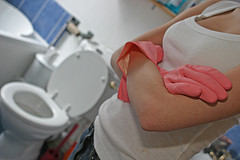
 Growing up, most of us learn to equate dirt with disease. A clean house is a healthy house, right?
Growing up, most of us learn to equate dirt with disease. A clean house is a healthy house, right?
Maybe not! It all depends on what you’re using to clean. According to the Environmental Health Association of Nova Scotia, “Many chemicals contained in household cleaning products are the same as those used in industrial settings. Many scientists are becoming concerned that long-term, low-level exposure to chemicals may be just as dangers as short-term, high-dose exposures. They also worry that we do not understand the impact of exposure to the cocktail of chemicals found in household air and dust.”
We researched a few common household cleaning products and found some surprising information. If you’ve got some of these items in your cupboards, you may want to consider replacing them.
Carpet cleaner. According to the Labour Environmental Alliance Society of Canada, some carpet cleaners can contain an ingredient called “2-butoxyethanol,” which if inhaled or absorbed through the skin, can cause blood disorders, liver damage, and kidney damage-even reproductive damage if exposure is long-term. In addition, they can contain perchloroethylene, a known cardcinogen, as well as 1,4-dioxane, ammonia, and unknown fragrances. If you clean the carpet in an entire room, your exposure could be high. Look for a non-toxic alternatives like those from Green Home, or make your own with these recipes.
Dishwashing soaps (hand). The Environmental Protection Agency has listed chloroform as a probable human carcinogen-capable of causing cancer. Did you know that if your dishwashing soap contains triclosan, that triclosan could react with chlorine in your water to create chloroform? Many areas use chlorine to clean the water supply, so even if you don’t add the chlorine yourself, it could still be there. Avoid dishwashing soaps with triclosan. Even dishwashing soaps without triclosan can contain quarternium 15, an irritant that can release formaldehyde. Look for natural alternatives like those from Seventh Generation.
Dishwashing detergents (automatic). Each time you put your dishes through the dishwasher, some residue is left that can later mix with your food. These detergents can contain chlorine-based sanitizing ingredients, as well as phosphates capable of choking off life in our rivers and streams. For a natural alternative, mix equal parts of borax and baking soda and store in a tightly sealed container. Use 2 tablespoons per load. If you have hard water, double the amount of baking soda.
Bleach. Bleach can irritate or burn the skin, eyes, and respiratory tract. If ingested, it can cause vomiting and injury to the esophagus. Combined with acidic toilet bowl cleansers or ammonia, it creates extremely toxic fumes. Furthermore, the chlorine in bleach can bind with organic material in the marine environment to create toxic compounds dangerous to fish. Use a bleach alternative, or try adding a cup of lemon juice to the wash cycle for whitening.
All purpose cleanser. According to Katherine Gallia, writing for “Natural Health,” all purpose cleansers can contain a synthetic solvent and grease cutter called “butyl cellosolve,” a hazardous petroleum-based chemical that can irritate skin and eyes, and over time, cause liver and kidney damage. Casey Kellar, author of Natural Cleaning for Your Home: 95 Pure and Simple Recipes, suggests a homemade alterative made by mixing the following in a spray bottle and shaking gently: 1 cup liquid Castile soap, ¼ teaspoon baking soda, ¼ teaspoon tea tree extract, 2 tablespoons witch hazel extract, and 4 drops of essential oil (your choice).
Are you using less toxic alternatives to clean your home? Please share any recipes you may have.
Photo courtesy ac hardman via Flickr.com.

